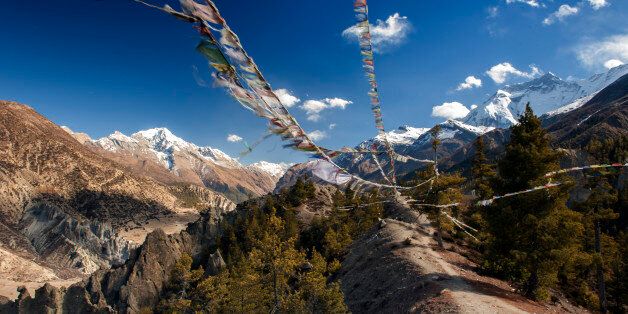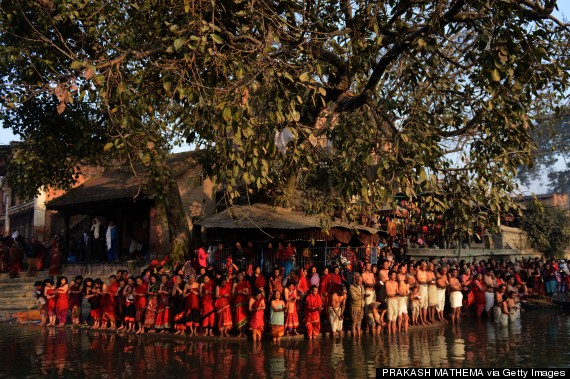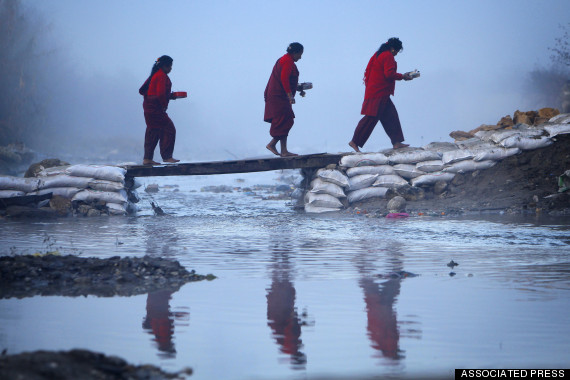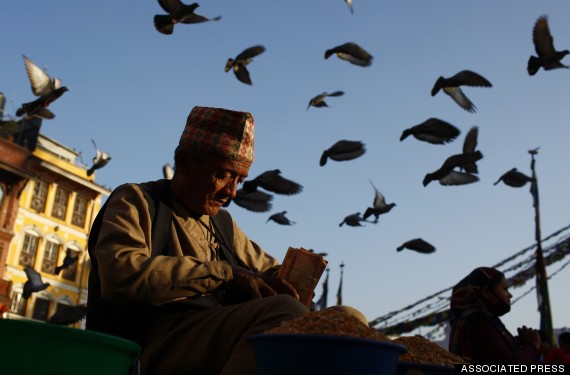
A single pomelo tree in Kathmandu is credited with feeding the creativity of writers, musicians and even politicians. But its owner, Karna Sakya, gets the credit for putting Nepal on the tourist map.
In 1968, the young Nepalese conservation officer resigned from his government post and opened a small hotel near that tree. Today, Karna owns eight eco-friendly Nepali hotels, employs 600 people and has won numerous environmental awards. He’s a bestselling author and adviser to the government, and he’s changed the face of tourism in Nepal forever.
It all started 46 years ago with the 13-room Kathmandu Guest House in the Thamel neighborhood of the capital. Back then, he says, there were only two types of visitors to the Himalayan kingdom: mountaineers and hippies. “Nepal was heaven for hippies. They’d travel overland from London in old buses.”
 Nepalese Hindu devotees perform a bathing ritual during the Swasthani Festival in the Hanumante River at Bhaktapur on the outskirts of Kathmandu, Feb. 3, 2015. (PRAKASH MATHEMA/AFP/Getty Images)
Nepalese Hindu devotees perform a bathing ritual during the Swasthani Festival in the Hanumante River at Bhaktapur on the outskirts of Kathmandu, Feb. 3, 2015. (PRAKASH MATHEMA/AFP/Getty Images)
From the late ’50s through the late ’70s, Kathmandu was one of the main stops on the hippie trail — a 6,000-mile route through Europe and the Middle East into Central and Southern Asia. Karna catered to these bohemian travelers, playing host to thousands over the years. “I learned so many things from them about philosophy,” he says. “Really that was the starting point of my life.” Along with hippies came artists, particularly musicians and writers, who found a creative oasis in the hotel’s garden. “Fifty or 60 books have been written under that tree,” Karna tells OZY proudly, referring to his pomelo-producing “energy point.”
But most folks came to read rather than write — to escape the hustle and bustle of Western cities and bask in some Himalayan serenity. Among the guests were many famous faces: Karna claims to remember seeing John F. Kennedy Jr. reading under the tree. Jeremy Irons and Ricky Martin, too.
Success was not instantaneous. He worked long hours and late nights for five or six years before the business took off. Later, as the hippie culture faded, and the Russian invasion of Afghanistan in 1979 made overland travel from London extremely dangerous, Karna focused more on trekking, wildlife walks and local tours, drawing on his own experience and knowledge as a conservation officer.
 Nepalese devotees cross the Salinadi River to perform rituals during the Swasthani Bratakatha festival in Sankhu, on the outskirts of Katmandu, Jan. 5, 2015. (AP Photo/Niranjan Shrestha)
Nepalese devotees cross the Salinadi River to perform rituals during the Swasthani Bratakatha festival in Sankhu, on the outskirts of Katmandu, Jan. 5, 2015. (AP Photo/Niranjan Shrestha)
From the beginning, his approach to tourism was always to prioritize the environment. He encourages guests to learn about and appreciate Nepal’s wildlife and landscape; his hotels follow eco-friendly practices with low-impact generators and tree-planting programs; he buys only from local suppliers who use zero-carbon delivery vehicles; and he’s even established his own water-bottling plant so he can be sure the drink containers get recycled. He’s the founder of Nepal’s first conservation NGO, the Nepal Nature Conservation Society, and his campaigning was fundamental to the creation of the Annapurna Conservation Area — the largest protected area in Nepal— managed by Nepal’s National Trust for Nature Conservation, for which he served as a trustee.
“He has been a role model in so many ways,” says Uttam Phuyal, who worked for Karna for 25 years before leaving to open his own hotel. “For him tourism has been bread and butter. He was the one who really developed Thamel as a destination. He was a pioneer,” Phuyal adds, noting that he runs his own hotel with similar eco-friendly principles.
These days Karna’s company, the KGH Group, has 650 rooms on offer and is the only homegrown hotel chain in Nepal. His flagship property, Park Village Resort, sits on five acres of landscaped gardens just 10 minutes’ drive from the heart of the capital. Cheaper long-haul flights mean many more ordinary tourists make it to Kathmandu these days — enough to fill Karna’s newer, larger hotels. And while a double room at his swankier establishments, costing $270 per night, would shock his earlier hippie guests, he hasn’t forgotten his origins; he offers a limited number of “ultra basic” rooms at the Kathmandu Guest House starting at just $2 per night for students trekking on a dime and even the occasional aging pothead.
 A Nepalese bird food vendor counts money while he awaits customers near the Boudhanath stupa, in Katmandu, Nepal, Nov. 10, 2014. (AP Photo/Niranjan Shrestha)
A Nepalese bird food vendor counts money while he awaits customers near the Boudhanath stupa, in Katmandu, Nepal, Nov. 10, 2014. (AP Photo/Niranjan Shrestha)
Of course, all successful entrepreneurs have critics. Detractors have called him stubborn and narrow-minded for his persistence in favoring environmental issues over economic concerns; one accused him of plagiarizing elements of his bestselling book Soch — although that accusation was later retracted. But few publically criticize the man deemed by many to be a Nepali hero.
Karna credits bonding with guests and caring for the environment for his success. He loves talking with clients and making new friends, noting that it’s visitors to Nepal who “become our ambassadors” when they return home.
And nurturing that pomelo tree — and its mythical powers — certainly hasn’t hurt either.